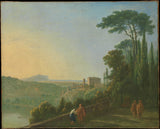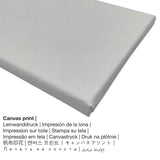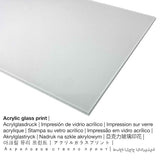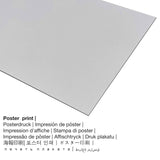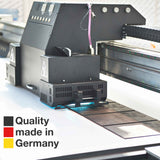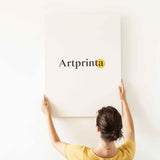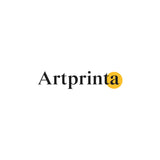Richard Wilson, 1756 - Lake Nemi na Genzano sitere na Terrace nke ebe obibi ndị mọnk Capuchin - mbipụta nka mara mma.
Ụtụ gụnyere. Mbupu gbakọrọ na ndenye ọpụpụ.
Akụrụngwa ndị ahịa anyị nwere ike ịhọrọ
The product dropdown menu provides you with the possibility to choose a material and a size of your choice. Hence, we allow you to choose among the following options:
- Kwaaji: A printed canvas, which should not be mistaken with a real canvas painting, is a digital image printed from a UV direct printer. It generates the typical impression of three-dimensionality. The great advantage of canvas prints is that they are relatively low in weight, meaning that it is quite simple to hang up your Canvas print without the use of any wall-mounts. A canvas print is suited for any type of wall.
- Bipụta akwụkwọ mmado n'ihe kwaaji: A poster is a UV printed cotton canvas paper with a granular finish on the surface. It is suited for framing the art print with the help of a custom frame. Please bear in mind, that depending on the size of the poster print we add a white margin of around 2-6cm round about the painting, which facilitates the framing with your custom frame.
- Mbipụta iko acrylic (nke nwere ezigbo mkpuchi iko): The print on acrylic glass, often labelled as a print on plexiglass, makes an artwork into brilliant décor. Your favorite artwork will be custom-made thanks to state-of-the-art UV direct print technology. It creates sharp, rich color tones.
- Mbipụta ọla (aluminium dibbond): An Aluminium Dibond print is a material with a true depth effect. The Aluminium Dibond Print is your best introduction to art replicas made on aluminum. This UV print on aluminium is the most popular entry-level product and is a truly contemporary way to showcase art prints, because it puts 100% of the viewer’s focus on the whole artwork.
Nkwupụta iwu: We try our utmost to depict our products as accurately as possible and to exhibit them visually. However, the tone of the print materials and the print result might differ slightly from the representation on your device's monitor. Depending on the screen settings and the nature of the surface, color pigments can unfortunately not be printed one hundret percent realistically. Since our are printed and processed by hand, there might as well be minor variations in the size and exact position of the motif.
Ozi izugbe sitere na The Metropolitan Museum of Art (© - site na The Metropolitan Museum of Art - www.metmuseum.org)
Wilson visited Lake Nemi, some twenty miles southeast of Rome in the Alban Hills, in 1754. This painting probably dates to 1756 or 1757, either just before or after he returned to London. The view, which combines topographical accuracy and picturesque idealization, is bathed in a soft, golden light that follows the precedent of artists active in Rome in the seventeenth century, especially Claude Lorrain.
N'elu 260 year-old artpiece was created by Richard Wilson. Nke kariri 260 afọ mbụ tụrụ nha: 16 7/8 x 21 1/8 na (42,9 x 53,7 cm). Mmanụ na kwaaji was applied by the artist as the technique for the work of art. The artpiece is included in the Ụlọ ihe ngosi nka nke Metropolitan mkpokọta, nke bụ otu n'ime ụlọ ngosi ihe nka nka kachasị ukwuu na nke kachasị mma n'ụwa, nke gụnyere ihe karịrị nde abụọ ọrụ nka na-agbasa puku afọ ise nke ọdịbendị ụwa, site na prehistory ruo ugbu a na site na akụkụ ọ bụla nke ụwa. ngalaba ọha A na-enye ibe nka site n'ikike nke Ụlọ ihe ngosi nka nke Metropolitan, New York, Onyinye George A. Hearn, 1905. : Gift of George A. Hearn, 1905. On top of that, alignment of the digital reproduction is in odida obodo usoro na akụkụ ruru nke 1.2: 1, nke pụtara na ogologo bụ 20% ogologo karịa obosara. The painter Richard Wilson was a European artist, whose art style was primarily Baroque. The Baroque painter was born in 1712 in Penegoes, Montgomeryshire, Wales and passed away at the age of 70 n'afọ 1782.
Tebụl nka nka
| Aha eserese: | "Lake Nemi and Genzano from the Terrace of the Capuchin Monastery" |
| Nhazi nka: | sere |
| Okwu nche anwụ: | nka ochie |
| Time: | 18th narị afọ |
| Emepụtara n'afọ: | 1756 |
| Afọ nka: | ihe karịrị 260 afọ |
| Ihe osise izizi: | mmanụ na kwaaji |
| Akụkụ nke ihe osise izizi: | 16 7/8 x 21 1/8 na (42,9 x 53,7 cm) |
| Ụlọ ihe ngosi nka / ebe: | Museumlọ ihe ngosi nka nke Obodo |
| Ebe ngosi nka: | New York City, New York, Njikota Obodo Amerika |
| Ebe nrụọrụ weebụ ihe ngosi nka: | Museumlọ ihe ngosi nka nke Obodo |
| Ụdị nka nka: | ngalaba ọha |
| Site n'aka: | Ụlọ ihe ngosi nka nke Metropolitan, New York, Onyinye George A. Hearn, 1905 |
| kreditline ọrụ nka: | Onyinye nke George A. Hearn, 1905 |
Nkọwa ngwaahịa
| Nkewa edemede: | mmepụta nka |
| Usoro mmeputakwa: | dijitalụ mmeputakwa |
| Usoro mmepụta: | Mbipụta UV / dijitalụ |
| Mmalite ngwaahịa: | Germany |
| Stockdị ngwaahịa: | na mmepụta ihe |
| Eji ngwaahịa a chọrọ: | ihe ndozi mgbidi, ihe ndozi ụlọ |
| Nhazi nka nka: | nhazi odida obodo |
| Oke akụkụ onyonyo: | 1.2: 1 (ogologo: obosara) |
| Pụtara nke akụkụ akụkụ: | ogologo bụ 20% ogologo karịa obosara |
| Akụrụngwa ị nwere ike ịhọrọ: | Mpempe akwụkwọ, akwụkwọ mmado (akwụkwọ kwaaji), mbipụta ọla (aluminium dibond), mbipụta iko acrylic (nwere ezigbo mkpuchi iko) |
| Nha n'arọwa n'elu ihe ndọtị (mbipụta akwa akwa): | 60x50cm - 24x20", 120x100cm - 47x39", 180x150cm - 71x59" |
| Mbipụta iko acrylic (nwere ezigbo mkpuchi iko) nhọrọ nha: | 60x50cm - 24x20", 120x100cm - 47x39", 180x150cm - 71x59" |
| Mpempe akwụkwọ mmado (akwụkwọ kwaaji) nha: | 60x50cm - 24x20", 120x100cm - 47x39" |
| Nhọrọ Dibond (ihe alumnium) nhọrọ: | 60x50cm - 24x20", 120x100cm - 47x39" |
| Nhazi nke nnomi nka: | adịghị |
Nyocha ngwa ngwa nke onye na-ese ihe
| aha: | Richard Wilson |
| Aha nka ndị ọzọ: | Wilson Of Birmingham, Richard Wilson, Wilson Richard of Birmingham, Wilson Richard, Richard Wilson of Birmingham, Wilson of Birmingham Richard |
| Gender: | nwoke |
| Obodo onye nka: | British |
| Ọrụ nke onye na-ese ihe: | onye na-ese ihe |
| Obodo obibi: | United Kingdom |
| Nhazi nke onye nka: | nna ukwu ochie |
| Ụdị nka: | Baroque |
| Afọ ọnwụ: | 70 afọ |
| Afọ ọmụmụ: | 1712 |
| Ebe omuma: | Penegoes, Montgomeryshire, Wales |
| Nwuru: | 1782 |
| Ebe ọnwụ: | Birmingham, West Midlands, England, United Kingdom |
© echekwabara ikike nwebiisinka, Artprinta.com

